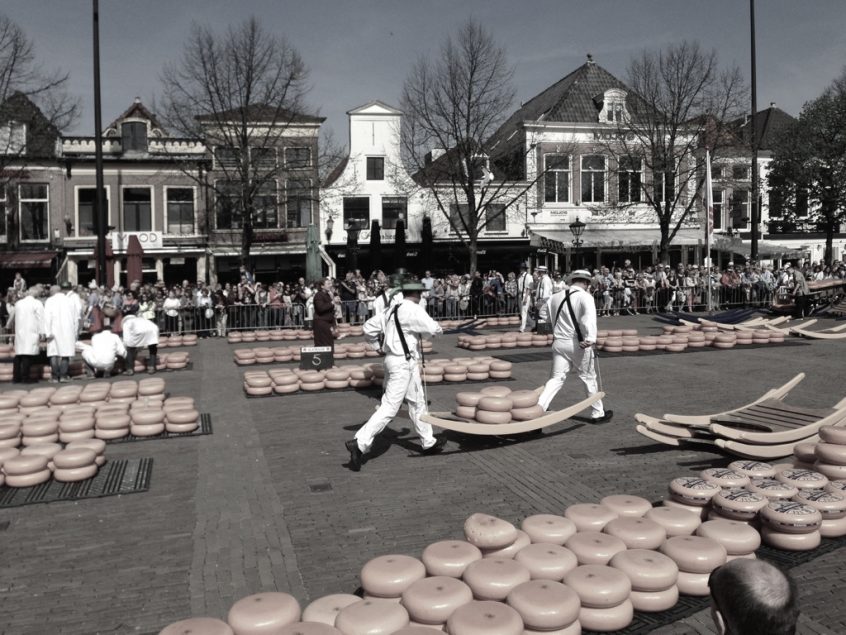Cheese Markets – 400 Years of Dutch Tradition
Say Cheeeesssseee!!! Gouda, Edam, Beemster, Maasdam, Roomano and more!
Along with windmills, bikes, tulips and family; cheese is certainly one of the first things that comes to mind when I think of the Netherlands.
A great deal of history and tradition are held in the making of cheese in The Netherlands. From the pasturing and milking of the Frisian cows to the region specialty and the curing process. One of the most interesting processes is the weekly weighing and trade of cheese at market in the traditional fashion. For practical reasons, cheese is now traded by modern means, however for the benefits of Summertime tourists the cities of Alkmaar, Gouda, Edam and Hoorn display the traditional spectacle and pageantry of a classic cheese market that dates back to the early 1600s.
I’d read and heard a lot about these markets but there was really nothing like seeing the demonstration in practice at the Waagplein in Alkmaar (10am-12:30pm every Friday from last Friday in March until the last Friday in September). Let me give you a little rundown on what goes on.
What are all those men dressed in white doing?

The men wearing white are the cheese bearers. In pairs, cheese bearers carry the cheeses around the market on ‘stretchers’ hung between them. The stretchers laden with cheese can weigh in the region of 120kg! To keep stretcher movement to a minimum and prevent them from hitting their legs, the cheese bearers walk in a special rhythm known as the cheese bearers’ trot.
There are 4 groups of 6 cheese bearers, known as the ‘warehouses’ – identified by their different coloured hats; green, blue, red and yellow. The man in the orange hat with a walking stick is the cheese father and presides over the 4 warehouses.
The cheese bearing profession is now an honorary job performed alongside permanent employment. Being a cheese bearer requires several months of training.

A special type of “cheese carry” called the “Child Carry”
On Market Day
Prior to the market opening at 10am, lorries filled with cheese wheels arrive from various cheese factories in Noord Holland. In old times the cheese would have been transported by horse-drawn carriages or canal boats. The cheese (in the order of 28,000kg) is unloaded and placed in the square in long rows on special mats.

Cheese arriving by canal boat.
The cheese bearers arrive around 9:30am, the cheese father calls the roll and announces how many tons of cheese are present at the market that day (latecomers are noted on the ‘shame board’ and must pay a fine – the money is used to sponsor a small local school).
At 10am the ring of a bell marks the opening of the cheese market and the samplers, traders and cheese bearers get to work!

Inspectors (wearing the long, white coats) inspect the cheese for quality by:
- inspecting the exterior
- knocking
- crumbling a piece between the fingers (extracted using a special cheese scoop) for texture and moisture.
- smelling
- tasting
- the number of holes or ‘eyes’ throughout the cheese are also inspected (these occur naturally from lactic acid bacteria during maturation). The eyes should be evenly spread throughout, and a cheese without eyes (a blind cheese) is considered inferior quality.
After inspection, a price (per kilo for the batch) for the cheese is negotiated. This bargaining process is done by shouting the prices and clapping hands – the last clap seals the sale.


The sold cheese now needs to be weighed so the cheese bearers carry it on stretchers to the Waaggebouw for weighing (photos above). Once weighed, the cheese bearers take the cheese-laden stretcher over to hand barrows. In the old days, these barrows would be filled with the cheese and the buyer would head off with his purchase. Nowadays, no real trade occurs at the market (it is just a demonstration of the tradition) so the cheese ends up heading back to the cheese warehouse on a lorry.
Here’s a cool video of the happenings in Alkmaar (not by me).
NOT a Tradition
The “Cheese Girls” seen walking around the markets wearing clogs, laced white hats and tunics are not traditionally part of the cheese markets. The cheese girl was introduced during the 1960s as an advertising character for Dutch cheese in Germany.
The Cheese
Why is the cheese round? (I asked the same question, don’t worry) Simple – to make it easier to transport to market. Each cheese wheel weighs roughly 12kg. In former days, women were typically the cheese makers while the men worked on the land. To make it easier for themselves, the women made cheese in the shape of a wheel so they could roll them.
North Holland is known for Gouda cheese. Much of the land is polder land (reclaimed from the sea) and the clay soil is rich in minerals which then also come through in the lush grass eaten by the cows. On such a nutrient-rich feed the cows produce a full, creamy milk, giving Gouda its rich flavour.
The Cheese industry in the Netherlands is enormous, comprising some:
- 1.6 million head of cattle
- over 18,000 dairy farmers
- producing 12.7 billion kg milk per year.
- 53 dairy factories
- 52% of milk produced is used in cheese production.
- producing almost a billion kg cheese each year and exporting 65% of this.
- Employing 60,000 people from the farmers through to retail and contributing 1.2% to the national economy.
- (figures from Dutch Dairy in Figures, Zuivel, 2014)
All of this in a country that is half the size of Tasmania in land space!
Alkmaar is more than just Cheese Markets.
The Waagplein (the square in Alkmaar where the market takes place each Friday) and its surrounds are typically packed with tourists on Friday mornings and into the early afternoon. Surrounding the traditional demonstration in the middle of the square there is no shortage of market stalls selling all the cheeses from all around holland, poffertjes, salted herring, clogs, tulips, stroopwaffels and more.


While you’re in Alkmaar, though, take the day to look around and explore the rest of the city. Do some shopping in the narrow streets lined with boutique stores, take a canal cruise, wander on a walking tour, if you haven’t had enough cheese already you can learn more at the Holland Cheese Museum and wash it down with a cold beverage at the Beer Museum.
Details and histroy regarding Alkmaar Cheese Market gained from http://hollandcheesemarkets.com/en/alkmaar/.

